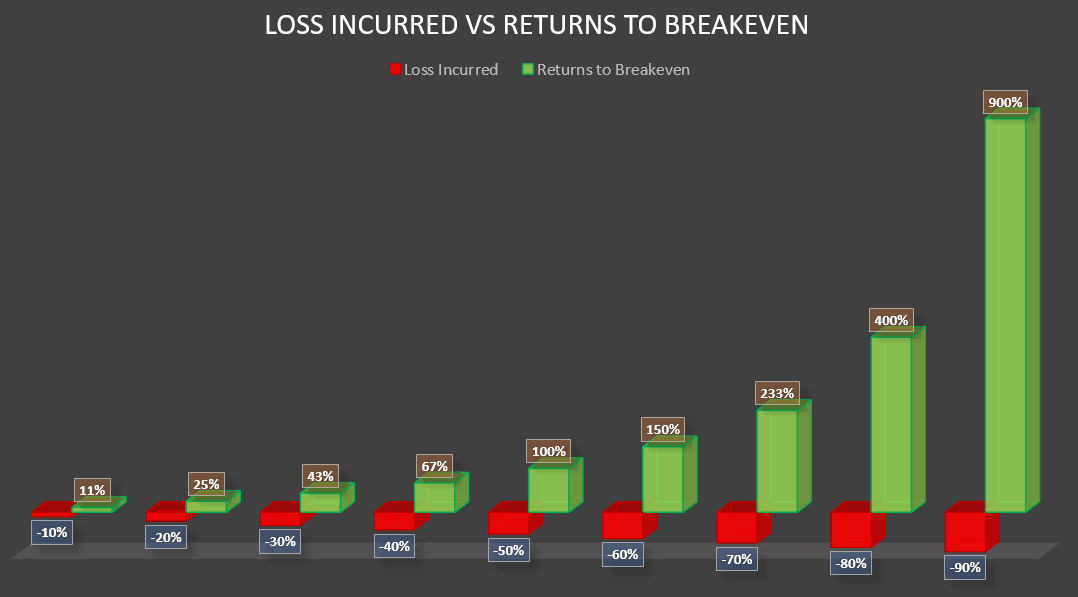When is the right time to sell your shares? How do you decide to sell your shares simple and do it confidently?

Contents
Shares Investing and Trading
Shares investing and trading potentially brings lucrative returns and done right is a positive source of wealth-building. However, there will be times when the right move to make is to sell some of the shares you are holding in your portfolio. It is easy for the media and others to affect us, and cause us to behave emotionally. Thus before you invest, you will always want to have your Personal Investment Plan in place.
When to Sell?
Reduce Losses
We all make mistakes, even professional investors who have invested for decades. The key thing is to realize when you have made a mistake and to cut losses as soon as possible. The bigger your lost (lost incurred %), the harder it is for another investment gains to cover your loss (returns to breakeven %).

Possible mistakes/drivers to reduce losses
- Investing on rumors/fake news/hot tips which fail to materialize.
- Analytical mistake with data/assumptions used.
- Unexpected material changes affecting the company’s profitability, growth, and shareholder returns.
Take Profits
A key investor behavior that prevents many from beating the street is the tendency to quickly sell our winning stocks but drag our feet on losing stocks. Above, we looked at reducing losses. But how about when should you take profits?
“The investor’s chief problem – and even his worst enemy – is likely to be himself.” ~Benjamin Graham
Possible times to take profit
- Rapid price appreciation especially if driven by speculation or manipulation.
- A healthy market uptrend with your stock gaining 20-25%.
- When a single stock or sector becomes very overweighted due to gains.
Redeploy Funds
If you find a better place with much better returns to redeploy your funds (after taking into account extra fees/costs), you may want to make the switch.
Changes to your portfolio can also be motivated by reducing risk by allocating your funds across markets and sectors.
Another possible reason to redeploy funds is to consolidate your holdings. It is crazy as an individual investor to hold and monitor 30-40 different individual shares. If well-planned, six to ten individual shares should give you sufficient diversification. This allow you to focon the companies in your portfolio.
Lastly, sometime unexpected events or circumstances occur and you may need to liquidate part of your shareholdings.

How to sell?
Reducing Losses
If you are trading, you should have a very specific cut loss set to make sure you do not lose more than the % you are willing to on a single trade.
If you are investing long term, you should a specific long-term minimum internal rate of return (IRR) / compounding annual growth rate (CAGR) that you are looking to achieve. If the investment no longer meets the objectives, it is time to plan your exit.
Taking Profits
Know that your natural human tendency is to sell your winners. Establish clear rules for selling stocks that have exceeded preset performance goals.
A good gauge would be if a stock performs 2-3x better than expectations and has become significantly overvalued. Technical indicators are helpful for you to see signs of an upcoming correction, as are comparing ratios with the stock’s competitors.
For long-term investors who have found an excellent young growth stock, the even more awesome years are ahead. Hold on tight!
Do not be in a rush to take all your profits at one time. Consider selling 1/2 to 1/3 of your stock holdings but continue to hold the rest. This helps reduce your capital outlay and allows you to pursue other investments while still enjoying future gains.
Redeploying Funds
For individual stocks, consider switching if you find a stock which performs significantly better (suggested min 5% better comparative performance).
For portfolio rebalancing, have your goal and plan in place earlier. Look at not only your current portfolio but future 12-month cashflow to be deployed into investments to form a picture of necessary adjustments to make. If your portfolio allocation is off by less than +/- 5%, you may want to just leave it as it is as the time and effort required to make frequent adjustments are usually not worth it.
The worst time to liquidate your shares is when you are forced to sell. This is why we always recommend everyone has their enough emergency savings in place before investing.


Leave A Comment